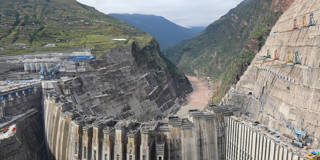The Communist Party of China's 1951 annexation of the water-rich Tibetan Plateau – the starting point of Asia’s ten major river systems – gave China tremendous power over Asia’s water map. In the ensuing decades, the country has made the most of this riparian advantage, but at an enormous social and environmental cost.
NEW DELHI – On July 1, the Communist Party of China (CPC) will stage a patriotic extravaganza to celebrate the 100th anniversary of its founding. Among the achievements it will celebrate is the Baihetan Dam, located on the Jinsha River, on the southeastern edge of the Tibetan Plateau. The dam will start operations on the same day.
The CPC loves a superlative. It is the world’s largest manufacturer and exporter, with the world’s largest foreign reserves. It boasts the world’s highest railway and the highest and longest bridges. It is also the world’s most dammed country, with more large dams than the rest of the world combined, and prides itself on having the world’s biggest water-transfer canal system.
The dams themselves are often superlative. The Three Gorges Dam is the world’s largest power station, in terms of installed capacity, and the Baihetan Dam is billed as the world’s biggest arch dam, as well as the world’s first project to use a giant one-gigawatt (GW) hydro-turbine generator. With 16 such generators, Baihetan ranks as the world’s second-largest hydroelectric dam (behind the Three Gorges Dam, at 22.5 GW).

NEW DELHI – On July 1, the Communist Party of China (CPC) will stage a patriotic extravaganza to celebrate the 100th anniversary of its founding. Among the achievements it will celebrate is the Baihetan Dam, located on the Jinsha River, on the southeastern edge of the Tibetan Plateau. The dam will start operations on the same day.
The CPC loves a superlative. It is the world’s largest manufacturer and exporter, with the world’s largest foreign reserves. It boasts the world’s highest railway and the highest and longest bridges. It is also the world’s most dammed country, with more large dams than the rest of the world combined, and prides itself on having the world’s biggest water-transfer canal system.
The dams themselves are often superlative. The Three Gorges Dam is the world’s largest power station, in terms of installed capacity, and the Baihetan Dam is billed as the world’s biggest arch dam, as well as the world’s first project to use a giant one-gigawatt (GW) hydro-turbine generator. With 16 such generators, Baihetan ranks as the world’s second-largest hydroelectric dam (behind the Three Gorges Dam, at 22.5 GW).